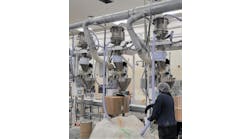Just when you think your plant is running just fine, someone in marketing wants you to change the product — slightly. This request may stem from customer input or in response to concerns about product quality. On the surface, it appears perfectly reasonable. However, your experience has shown that small changes to a particulate solid can upset the process in very unpleasant ways.
When asked to help with this issue, I start with the model the plant used to design the original process — if it has one. Older plants often lack one because modeling of solids processes is a rather recent phenomenon. However, today we can call upon several sophisticated and exciting tools:
• Unit operations design modules for various solids processing operations: drying, filtration, agglomeration and even conveying operations;
• Computational fluid dynamics (CFD) programs that finally are becoming user-friendly, especially in laying out the grids and reducing run time; and
• Computational chemistry (CC) programs that are able to run some problems involving solids.
If you don’t have these tools, I suggest getting them and training your staff on how to use them.
The learning curve on these tools only will get steeper if you wait too long before using them. I recently bought an all-electric car and discovered a new way to drive that markedly reduces the drudgery. This car even can come when I call it on my cell phone! When people ask why I ventured into this technology, I remind them that lots of folks made a leap of faith in 1903 by buying a product from a guy named Henry Ford. They wanted to be part of that technological movement. It’s also the reason why Chemical Processing’s editor bought a scan tool (see: “Automation: Zeroes and Ones Add Up But...”). While his can’t do everything that a more sophisticated device can, he may be able to diagnose many simple problems and fix them.
Like an old dog learning new tricks, I struggled in the early days to master CFD, CC and even a few of the flow modeling programs. I started with some CFD programs that used simple mesh designs. These, available free from the National Aeronautics and Space Administration, gave great insight into the flow of particulate solids. Prior to these programs, we had to set up elaborate scale models and visually trace particles to determine the best way to separate or blend them. With these programs, in one instance I was able to find an elbow design that allowed U.S. Environmental Protection Agency method-five sampling to be representative after a half-radius bend. This enabled conducting sampling in an hour rather than ten hours using conventional methods that required a special dispensation from a regulation that specified hourly samples.
Our pharmaceutical division had been straining to deal with the tremendous workload of investigating new drug candidates. A few years earlier I had found a program published by IBM as freeware to estimate the reactions between different elements. I used it to predict reactions in the gas phase for the reduction of nitrogen oxides. With a little tweaking, the same program worked well in estimating the potential polymorphs of a chemical by estimating the backbone energy of the variations.
A research program in our pharmaceutical division encountered a clumping problem that I suggested might stem from a polymorph. The researchers hadn’t been able to find any polymorphs in their investigation until one of the chemists pointed out that she may have seen one. I ran my little program and discovered six possibilities — with two being very likely. Later, this was confirmed and a method developed to avoid the troublesome chemical. The division went on to purchase a more-comprehensive program, reducing development time of new drug candidates.
You must use process flow models if you want to improve or alter a product and still understand how byproducts or energy requirements will change. That’s the first step you should take when asked to change a product slightly. You may want to look at models for unit operations along with CFD and CC programs. Start with simple programs, especially free ones. This will allow you to find what features are important when subsequently buying commercially available software.



